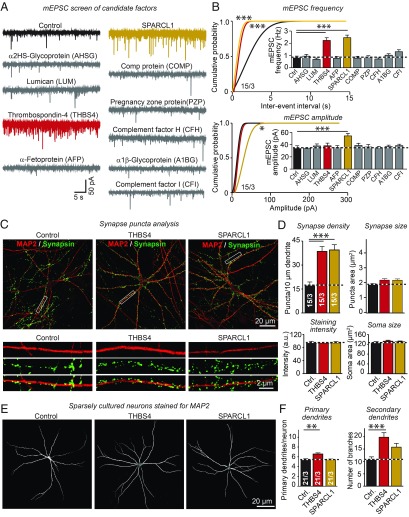Fig. 5.
THBS4 and SPARC-like protein 1 (SPARCL1) increase spontaneous synaptic responses, synapse density, and dendritic branching. (A and B) Screen of recombinant candidate proteins enriched in young or old serum identifies THBS4 and SPARCL1 as potent stimulators of synapse formation. Proteins secreted into the medium of transfected HEK293T cells expressing candidate factors were concentrated by ultrafiltration and added at DIV35 to the neuronal growth medium (final concentration, 1.43%) in the absence of serum. Neurons were analyzed by mEPSC recordings at DIV40–42 (A, representative traces; B, cumulative probability plots of mEPSC interevent intervals. Inset: summary graph of the mEPSC frequency; and of mEPSC amplitudes, Inset: summary graph of mEPSC amplitudes). (C and D) Recombinant THBS4 and SPARCL1 increase the synapse density of human neurons (C, representative images of control and treated neurons immunostained for MAP2 and synapsin; B, quantification of synapsin puncta density, area and intensity on proximal dendrites of control, and factor-treated human neurons). (E and F) Recombinant THBS4 and SPARCL1 increase dendritic branching in human neurons (E, representative images of sparsely plated human neurons immunostained with MAP2 to visualize dendritic arborization; F, quantification of primary dendrites per neuron and number of dendritic branches). All bar graphs are means ± SEM; numbers of cells per independent cultures analyzed are shown within the bars. Statistical significance (*P < 0.05; **P < 0.01; ***P < 0.001) was evaluated with one-way ANOVA followed by Dunnett’s post hoc test (B) or Tukey’s post hoc test (D and F), or by Kolmogorov–Smirnov test (cumulative probability plots in B). For the production of recombinant THBS4 and SPARCL1 and sample images, see SI Appendix, Fig. S5.

